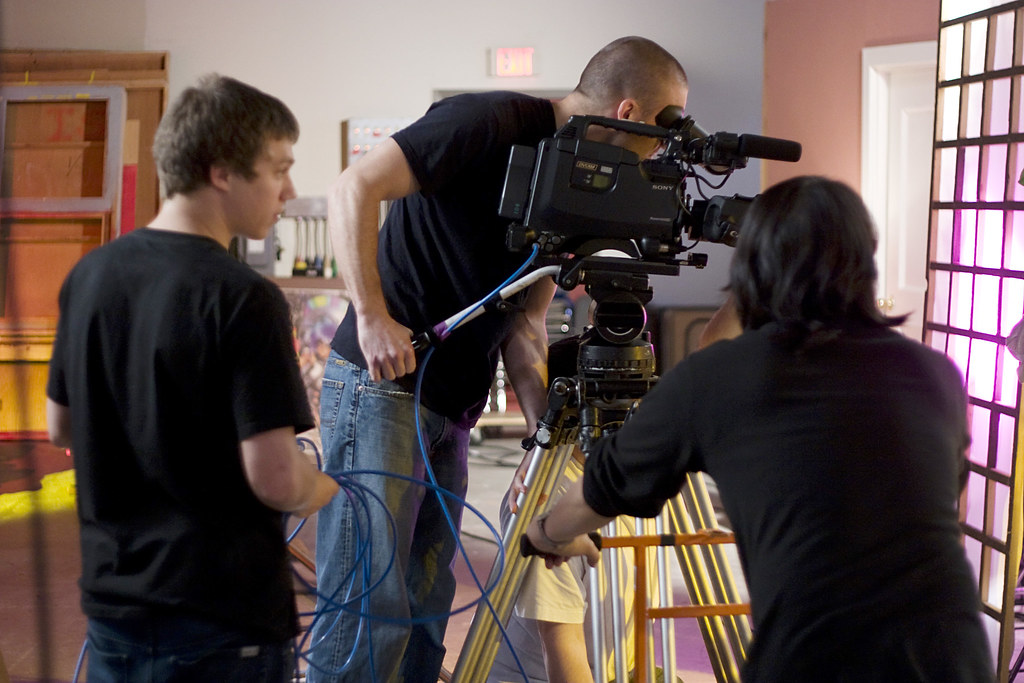Music production is an essential aspect of the modern-day music industry. This essay on music production is a comprehensive guide that will explore the techniques used in music production to create high-quality audio tracks. From the history of music production to the tools, software, and techniques currently used in the industry, this essay will provide an overview of the subject. Readers will learn about the challenges and opportunities facing music producers, as well as the future of music production in the digital age. Whether you’re a music enthusiast or a budding music producer, this essay will provide you with valuable insights into the world of music production.
Table of Contents

Introduction
Music production is the process of creating, recording, mixing, and mastering music tracks. It involves selecting the right equipment, setting up the studio, and guiding the creative process. Essentially, music production is the art of taking a musical concept and transforming it into a polished product that is ready for distribution to an audience.
The importance of music production in the music industry cannot be overstated. It ensures that the music tracks are of high quality and meet the standards of the industry. The music producer is responsible for guiding the artists and ensuring that their vision is realized in the final product. Through their expertise, they are able to enhance the overall sound quality of the music and make it stand out.
Without music production, the music industry would not be able to produce high-quality music tracks that meet the expectations of the audience. This means that the creative vision of the artist would be lost, and many talented artists would not be able to showcase their abilities. In essence, music production is an essential part of the music industry and is crucial to the success of music tracks.
The History of Music Production
Music production has come a long way since the early days of music recording. In the 1800s, music was recorded onto wax cylinders using a phonograph. The gramophone was later introduced, which used vinyl records to record music. In the 1940s, tape recorders were introduced, which allowed for multi-track recording, giving producers the ability to record multiple tracks simultaneously.
Over time, music production has continued to evolve with the introduction of new technologies. Digital technology has made music production more accessible and affordable. The introduction of digital audio workstations (DAWs) has revolutionized music production, making it easier for producers to create high-quality music tracks. Today, music production has become a global phenomenon, with producers able to create and share music with audiences across the world.
Several key figures and innovations have contributed to the evolution of music production. Les Paul, for example, invented the multi-track recorder, which allowed for the recording of several tracks simultaneously. Phil Spector is another notable figure in the history of music production, known for his use of the “Wall of Sound” technique, which involved layering multiple instruments and vocal tracks to create a dense, orchestral sound. Other key figures include George Martin, who produced many of the Beatles’ albums, and Brian Eno, who is known for his work with ambient music.
Overall, the history of music production is a testament to human creativity and innovation, and the ways in which technology has enabled us to bring our musical ideas to life.

Techniques for Music Production
Pre-production is a crucial phase in music production as it sets the foundation for the rest of the process. Effective pre-production techniques help to ensure a successful outcome. Here are some helpful pre-production techniques:
1. Concept Development
The first step in pre-production is to develop a concept for the music production. This involves identifying the overall sound, style, and mood of the music, as well as the intended audience. Collaborating with the artist to create a clear and concise concept that guides the creative process is essential.
2. Songwriting and Arrangement
Once the concept is established, the producer and artist should focus on songwriting and arrangement. Selecting the right instruments, creating a melody, and structuring the song are key. The producer should work with the artist to ensure that the song is well-crafted and will resonate with the intended audience.
3. Selecting Equipment and Setting Up the Studio
The producer should select the right equipment and set up the studio for recording. This involves selecting microphones, instruments, and other equipment, as well as arranging the space for optimal sound quality. The producer should work with the artist to ensure that the studio is conducive to creativity and productivity.
Recording involves capturing the sound of the instruments and vocals. The following are effective recording techniques:
1. Microphone Placement
Microphone placement is crucial to capturing high-quality sound. Experimenting with different microphone positions to find the optimal placement for each instrument and vocalist is recommended.
2. Monitoring and Adjusting Levels
During the recording process, the producer should monitor the sound levels and adjust them as needed. This ensures that each instrument and vocal track is recorded at the correct volume and that the sound is balanced.
3. Capturing the Best Performance
Finally, the producer should work with the artist to capture the best performance possible. Creating a comfortable and supportive environment for the artist and providing feedback and guidance throughout the recording process is important.
Mixing and mastering are the final steps in the music production process. These techniques ensure that the final product is polished and ready for release. Here are some effective mixing and mastering techniques:
1. Balancing and EQing Tracks
During mixing, the producer should balance the levels of each track and adjust the EQ to ensure that each instrument and vocal is clear and well-defined.
2. Adding Effects and Processing
The producer should also experiment with adding effects and processing to each track to create depth and character in the sound. This may include reverb, delay, compression, and other effects.
3. Finalizing and Mastering
During mastering, the producer should finalize the sound of the track. This involves adjusting the overall volume, adding compression, and ensuring that the track sounds balanced on all devices.
There are many resources available for music producers to improve their skills and stay up-to-date with industry trends. Here are some helpful resources:
1. Online Communities and Forums
Online communities and forums, such as Reddit’s r/WeAreTheMusicMakers or the Gearslutz forum, provide a platform for music producers to connect with others in the industry, ask questions, and share knowledge.
2. YouTube Tutorials and Courses
YouTube is a great resource for music producers looking to improve their skills. There are many tutorials and courses available on topics such as mixing, mastering, and using specific software.
3. Music Production Software and Tools
There are many software and tools available to music producers, such as digital audio workstations (DAWs), plugins, and virtual instruments. These tools can help producers create high-quality music tracks and experiment with different sounds and effects.

Tools and Software for Music Production
Music production requires the use of advanced tools and software to achieve the best results. Here are some of the most popular and widely used tools and software in the music production industry:
A. Digital Audio Workstations (DAWs)
Digital Audio Workstations (DAWs) are essential tools for music production. They allow producers to record, edit, and mix music tracks. Some popular DAWs include:
- Pro Tools: widely considered a standard in the industry, Pro Tools is known for its powerful editing capabilities and flexibility.
- Logic Pro: favored by musicians and producers in the electronic and hip-hop genres, Logic Pro is known for its ease of use and intuitive design.
- Ableton Live: popular among electronic music producers and live performers, Ableton Live is designed for real-time manipulation and triggering of audio loops and samples.
B. Plugins and Virtual Instruments
Plugins and virtual instruments are software tools that allow producers to add effects and create unique sounds. Some popular plugins include:
- Waves: known for its high-quality audio processing plugins, Waves has a wide range of tools for EQ, compression, reverb, and more.
- FabFilter: with a focus on intuitive design and advanced features, FabFilter has plugins for EQ, compression, distortion, and more.
- iZotope: known for its innovative and creative plugins, iZotope has tools for audio restoration, vocal processing, and creative sound design.
Virtual instruments allow producers to create realistic sounds using digital technology. Some popular virtual instruments include:
- Native Instruments Kontakt: a versatile sampler that allows producers to create realistic instrument sounds, sound effects, and more.
- Spectrasonics Omnisphere: a powerful synth with a vast library of sounds and presets, Omnisphere is favored by producers in the electronic and film scoring genres.
- XLN Audio Addictive Drums: a versatile drum plugin with a wide range of sounds and styles, Addictive Drums is popular among producers in the rock and pop genres.
C. Hardware for Music Production
Hardware such as microphones, mixers, and monitors are essential tools for music production. Quality hardware ensures that the sound is of high quality and meets the standards of the industry. Some popular hardware includes:
- Shure SM7B: a popular microphone for recording vocals and instruments, known for its warm and detailed sound.
- Universal Audio Apollo: a high-end audio interface that provides pristine audio quality and allows for real-time processing of effects and plugins.
- KRK Rokit: a popular set of studio monitors that provide accurate and detailed sound reproduction, and are favored by many producers and engineers.
D. Comparison of Different Music Production Tools and Software
With so many different music production tools and software available, it can be difficult to choose the right one. The choice of tools and software will depend on the producer’s preferences, budget, and the type of music being produced. It is important to research and compare different options before making a decision. Some factors to consider include:
- Features and capabilities: different tools and software offer different features and capabilities, so it is important to choose one that meets your specific needs.
- Ease of use: some tools and software are more intuitive and user-friendly than others, so it is important to choose one that is easy to use and navigate.
- Compatibility: some tools and software are only compatible with certain operating systems or hardware, so it is important to choose one that is compatible with your setup.
- Price: music production tools and software can vary widely in price, so it is important to choose one that fits within your budget.

Examples of Music Productions
Including examples of successful music productions can provide readers with a better understanding of the music production process. In this section, we will highlight a few examples of successful music productions and break down the production process to discuss the techniques and tools used to create the final product.
Bruno Mars – “Uptown Funk”
“Uptown Funk” is a hit song by Bruno Mars that has been widely popular since its release in 2014. The song was produced by Mark Ronson and features Bruno Mars on vocals. The production process involved the use of various techniques and tools that contributed to the song’s success.
Pre-Production Techniques
Before the production process began, the team behind “Uptown Funk” spent a significant amount of time in the pre-production phase. This involved creating a clear vision for the song and outlining the various elements that would be included in the final product. The team also worked on the song’s structure, determining the order of verses, choruses, and other sections.
Recording Techniques
During the recording process, the team used a combination of live instrumentation and digital software to create the desired sound. The song features a prominent bassline, which was recorded using a live bass guitar. The drums were recorded digitally, using a combination of electronic drum samples and live drum recordings.
Mixing and Mastering Techniques
Once the recording process was complete, the team moved on to the mixing and mastering phase. During this phase, the individual tracks were combined and balanced to create a cohesive sound. The team also used various effects and plugins to enhance the sound of the individual tracks and create a polished final product.
Tools and Software Used
The production of “Uptown Funk” involved the use of various tools and software, including Ableton Live, Pro Tools, and Logic Pro X. The team also used a variety of plugins and effects, such as the Waves SSL E-Channel, to shape the sound of the individual tracks.
Conclusion
By breaking down the production process of a successful music production like “Uptown Funk,” readers can gain a better understanding of the techniques and tools used in the music production process. This can help aspiring music producers to learn new skills and incorporate them into their own productions.

Challenges and Opportunities in Music Production
A. Challenges Faced by Music Producers
Music production is a challenging and rewarding field that requires a lot of hard work and dedication. Producers often face tight deadlines, budget constraints, and the need to balance creative vision with commercial success. Meeting the expectations of the industry and the audience is a daunting task for many producers, as they strive to create a high-quality product that stands out in a crowded marketplace.
In addition to these challenges, music producers must also navigate the ever-changing landscape of the music industry. With the rise of streaming services and digital downloads, the way that music is consumed and distributed is constantly evolving. Producers must stay up-to-date with the latest trends and technologies to ensure that their work remains relevant and successful.
B. Opportunities for Innovation and Creativity in Music Production
Despite the challenges, there are many opportunities for innovation and creativity in music production. Digital technology has made music production more accessible and affordable, allowing for greater experimentation and creativity. Producers can now create music from anywhere in the world and collaborate with artists from different genres and cultures, creating unique and exciting music tracks.
Advancements in technology have also made it possible for producers to experiment with new sounds and styles, pushing the boundaries of what is possible in music production. With the right tools and software, producers can create music that is truly groundbreaking and innovative.
C. Future of Music Production in the Digital Age
The future of music production looks bright in the digital age. With the continued development of digital technology, music production will become even more accessible and affordable. Producers will have access to new tools and software, allowing for greater innovation and creativity. The industry will continue to evolve, and music production will play a crucial role in shaping the future of music.
As technology continues to advance, there will be even more opportunities for collaboration and experimentation in music production. With the rise of virtual reality and immersive technologies, producers will be able to create music experiences that are truly immersive and interactive.
In conclusion, music production is a challenging and rewarding field that offers many opportunities for innovation and creativity. While producers must navigate a constantly changing industry, the future looks bright for music production in the digital age. The possibilities are endless, and the only limit is the creativity and imagination of the producer.
Conclusion
To sum up, music production is a dynamic and intricate process that necessitates a blend of technical expertise and artistic imagination. By implementing efficient pre-production, recording, mixing, and mastering techniques, music producers can deliver top-quality music tracks that meet the demands of the industry and the listeners. It’s crucial for music producers to keep themselves updated with the latest industry trends and to continually refine their skills through resources like online communities, YouTube tutorials, and music production software and tools. This will help them attain success in the competitive and constantly evolving realm of music production.
Don’t forget to check out our other music production content for more valuable insights and tips.
Frequently Asked Questions
Who invented the multi-track recorder?
Les Paul invented the multi-track recorder.
What is the importance of music production?
Music production ensures high-quality tracks meet industry standards.
How do you select the right equipment for recording?
Select equipment based on the sound you want to achieve.
What if I don’t have a lot of money for equipment?
There are affordable options available for music production.
How long does it take to produce a song?
The time it takes to produce a song varies depending on many factors.
What if I don’t have a lot of experience in music production?
There are many resources available to help beginners learn.


